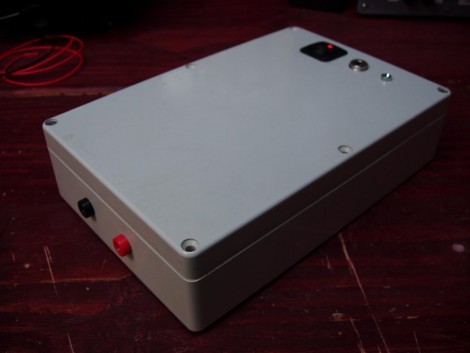
[Punish3r] wanted to have power for prototyping on the go. What he came up with is this little thing above. Inside you’ll find common components that let the unit provide 10 amp hours of current with a 12V 500mA output.
The storage capacity is provided by a dozen Lithium batteries. These 3.7V cheapies are wired in parallel behind a protection board. For charging and discharging, a Sparkfun LiPo charger board was used, taking care of all the work necessary to top off the batteries using a wall-wort. The final piece in the puzzle is a boost converter that provides the regulated 12v connected to the red and black banana plug receivers on the bottom of the case.
This is very much a plug-and-play design… just make sure you hook the parts up correctly and you’re up and running. We would love to see a roll-your-own boost converter circuit that include a switch or dial that lets you select common PSU voltage levels. If you’re going to the trouble to make your own board you might as well incorporate the charging circuit at the same time.
[Thanks Paul]














‘wart’ rather than ‘wort’?
I hate when they rate batteries in milliamp hours! This would be fine if this was fairy land but real batteries drop voltage as they drain. Watt hours is the best way of measuring it because it takes the drop into account and is a proper measurement of energy
@gmcurrie It is quite l4m3 when the only thing you have to add is spell correction.
On topic: This was really well thought and made. He even added a flame retardant case! Does the protection board protect against short-circuits? I couldn’t get that piece of info from TFA.
“If you’re going to the trouble to make your own board you might as well incorporate the charging circuit at the same time.”
That’s the popular way to do things these days. Removable batteries aren’t a bad way to go either, that way on longer trips you can take spares then charge them when you get home.
Nice build btw
@MrX
Yeah, bit pedantic, just kinda niggles – if making $ from knocking off a precis of someone else’s handiwork, at least give them the good justice of proper proof-reading.
Wouldn’t a sealed lead acid battery do the job? Or am I missing the point?
Why not just carry around a 12V lead acid battery, found in every car? The smallest ones supply 40Ah, no electronics that can break, and no fire hazard.
Considering most car batteries weigh a minimum of 30 pounds, then that could get heavy quick. The bench I am working on at the house will go that route though. I have a giant commercial battery at the house (Out of a semi) that isn’t doing nothing but jumping off the occasional car.
Where is the regulated 5 and 3.3 volt outlets? Any self respecting bench supply would have more than 12 volt out. Something like this with a variable voltage and current control would be quite useful. Throw in a function generator all in the same form factor and I’m sold.
Very nice work and a clean build!
I built something similar for use with my 2-meter ham radio years ago.
I still have my “uniteruptable DC power supply” in the closet, waiting for a new SLA battery.
I used a 7ah SLA, and a few other OTS parts, like a smart charging circuit, switching power supply, and a relay and built the whole thing into a larger size ammo box for portability with some ruggedness.
While plugged in, the power supply, uh…supplied power while the smart charger maintained the battery. When unplugged or interrupted the relay would close and the battery would then supply power.
Power projects are fun as hell.
wall WART…
Thanks for all the praise!
(I agree with “wart”, as “wort” is actually pronounced “wurt” and is a term of the brewing industry.)
@vtl:
I will be sure to lower my sample rate and integrate the curve for ya the next chance I get. :)
@MrX:
The PCM (protection board) monitors both the pack voltage and temperature. If either goes outside their preset windows, the ability to charge or discharge the pack is blocked by the PCM. It’s a one-time-use component, but at $2.75 I view it as cheap insurance.
@nanomonkey:
The idea was to provide a single, relatively high output that could be regulated down to the required voltage. As the majority of my designs are stand-alone, some kind of regulation or voltage conversion is implicit, and I would rather see a prototype’s reactions with its “real” power regulator in place, rather than some idealized lab supply.
That being said, my original intent was to have 5V and 3.3V on the box… :) And there is PLENTY of room to do 3.3/5/Var and a function generator board (oh, and panel meters!); easily 70% of the case volume is still available. (I have/had made a comment on HackHut about the atrocious volumetric efficiency)
needs a few more failsafes methinks, including a circuit breaker on the output and a timer so if the controller throws a wobbly due to out of spec input voltage etc and carries on charging it will shut off and flash an error light.
I ran into this little problem once with a cheap charger, by the time I’d noticed that the charging light was flickering the battery was too hot to touch and bulging.